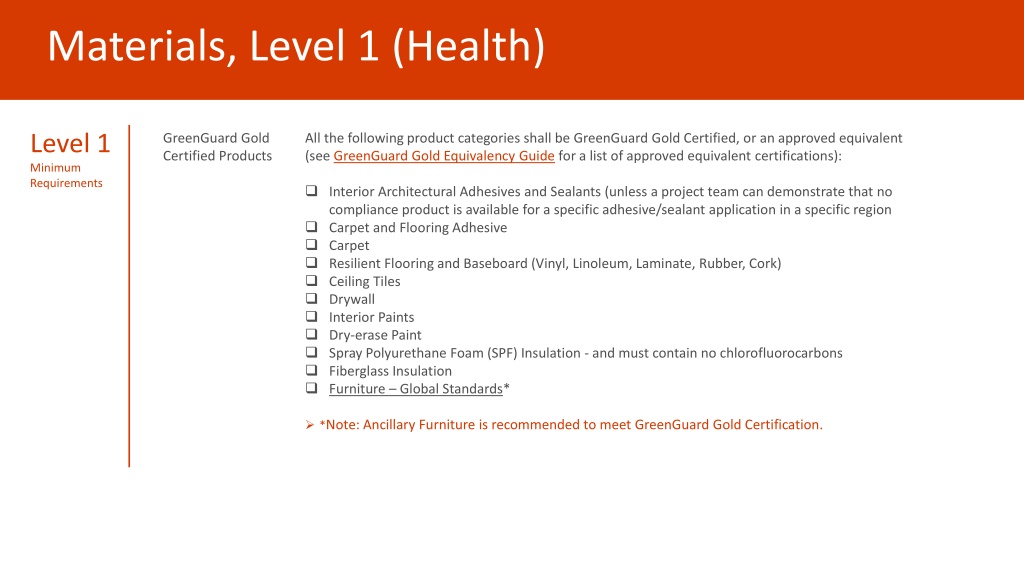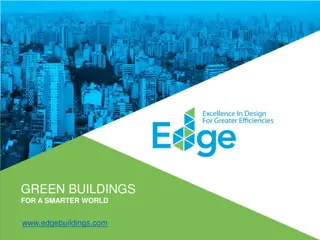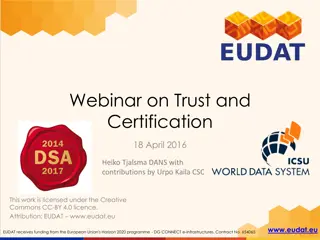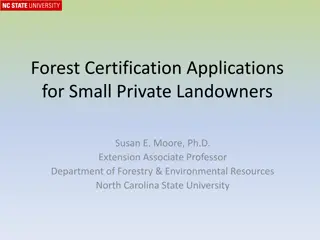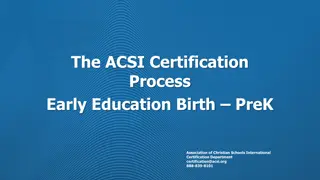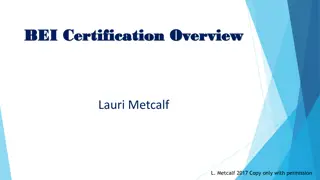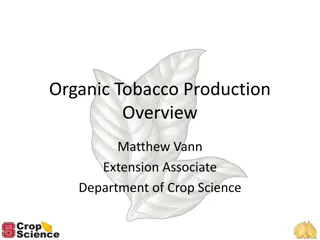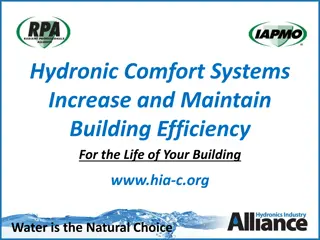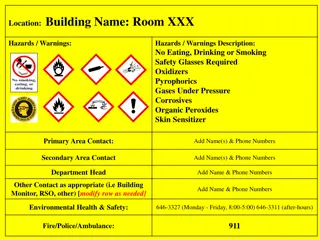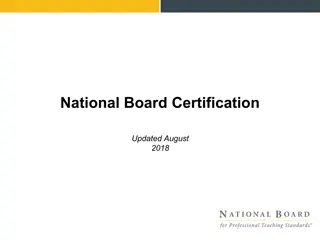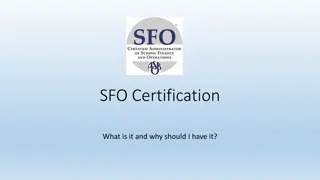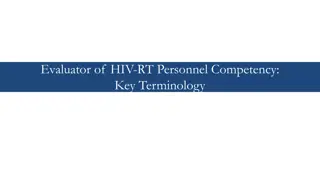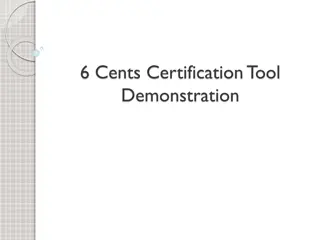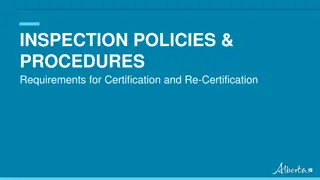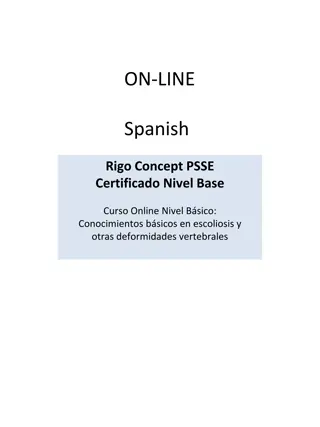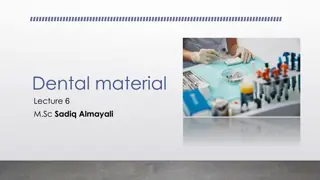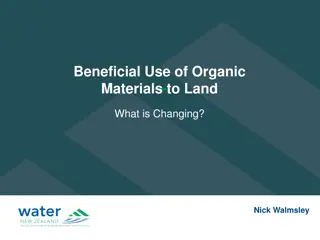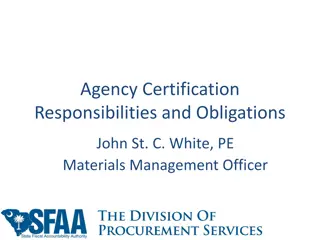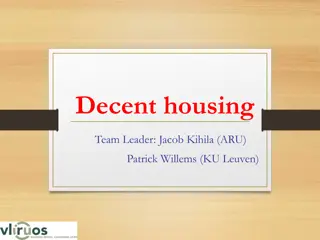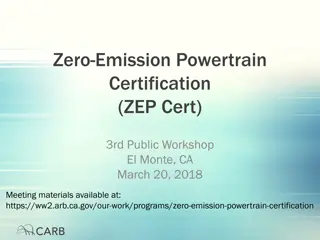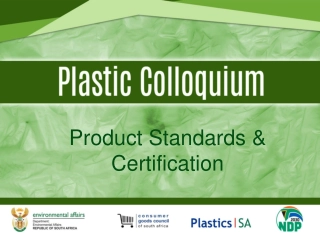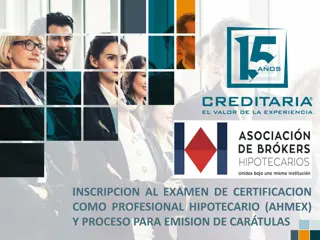Sustainable Building Materials Certification Guidelines
This document outlines the minimum requirements for Level 1 (Health) and Level 2 (Leadership) certification of building materials, focusing on GreenGuard Gold certification for various product categories including adhesives, flooring, paint, insulation, furniture, and wood products. Additionally, it details specific requirements for wood floors, millwork, and sourcing of raw materials to meet LEED criteria. Emphasis is placed on using environmentally friendly materials with low emissions and recycled content.
Download Presentation

Please find below an Image/Link to download the presentation.
The content on the website is provided AS IS for your information and personal use only. It may not be sold, licensed, or shared on other websites without obtaining consent from the author. Download presentation by click this link. If you encounter any issues during the download, it is possible that the publisher has removed the file from their server.
E N D
Presentation Transcript
Materials, Level 1 (Health) Level 1 Minimum Requirements GreenGuard Gold Certified Products All the following product categories shall be GreenGuard Gold Certified, or an approved equivalent (see GreenGuard Gold Equivalency Guide for a list of approved equivalent certifications): Interior Architectural Adhesives and Sealants (unless a project team can demonstrate that no compliance product is available for a specific adhesive/sealant application in a specific region Carpet and Flooring Adhesive Carpet Resilient Flooring and Baseboard (Vinyl, Linoleum, Laminate, Rubber, Cork) Ceiling Tiles Drywall Interior Paints Dry-erase Paint Spray Polyurethane Foam (SPF) Insulation - and must contain no chlorofluorocarbons Fiberglass Insulation Furniture Global Standards* *Note: Ancillary Furniture is recommended to meet GreenGuard Gold Certification.
Materials, Level 1 (Health) All wood floors shall contain no added formaldehyde (NAF) and ultra-low emitting formaldehyde-based resins (ULEF). This shall be documented by a letter of confirmation from the manufacturer. Level 1 Minimum Requirements Wood Floors *Note: For laminate or engineered wood, see the requirement for Resilient Flooring Millwork Except reclaimed wood, all millwork shall contain no added urea formaldehyde (NAUF). This shall be documented by a letter of confirmation from the manufacturer. All composite wood products, including hardwood plywood, particle board, and medium density fiber board shall contain no added urea formaldehyde (NAUF). This shall be documented by a letter of confirmation from the manufacturer. Composite Wood 1. Advantages of FSC. https://us.fsc.org/en-us/what-we-do/advantages-of-fsc
Materials, Level 2 (Leadership) All permanently installed wood shall be either reclaimed wood or certified by the Forest Stewardship Council (FSC). Small exceptions may be made if FSC-certified products are unavailable in some regions, but for all projects, at least 50% of permanently installed wood should comply with this requirement. Level 2 Minimum Requirements Wood Floors and Millwork Meet Option 2 of the LEED "Building product disclosure and optimization - sourcing of raw materials" credit: Leadership Extraction Practices or the prescriptive recycled content criteria for the materials below. LEED BPDO Sourcing of Raw Materials Credit Specify 25% post-consumer recycled content Collect Environmental Product Declaration (EPD) - Product Specific Type III EPD Ceiling tiles Collect Environmental Product Declaration (EPD) - Product Specific Type III EPD Gypsum Board Specify 30% pre-consumer recycled content Specify 5% post-consumer recycled content OR 5% bio-based material content Collect Environmental Product Declaration (EPD) - Product Specific Type III EPD Carpet Specify 25% post-consumer recycled content Collect Environmental Product Declaration (EPD) - Product Specific Type III EPD Aluminum Specify 50% pre-consumer recycled content for foundations and topping slab Specify 25% pre-consumer recycled content for vertical applications Collect Environmental Product Declaration (EPD) - Product Specific Type III EPD Concrete Collect Environmental Product Declaration (EPD) - Product Specific Type III EPD Glass/ Glazing
Materials, Level 3 (Carbon) All projects must develop a strategy at project concept phase to reduce embodied carbon from project life cycle. Engage with Microsoft Sustainability Lead at early design stages (concept or schematic design) to develop a project specific strategy to reduce embodied carbon. Best-practices for embodied carbon reduction includes the assessment of embodied carbon of building materials through: 1. Optimizing high-embodied-carbon system within a building (e.g. structural systems, envelope systems, finishes and etc) and substituting those material systems with low- embodied-carbon options. The AIA Materials Matter is a great resource. 2. Assessing embodied carbon with a whole-building life-cycle assessment (WBCLA). This method uses an LCA software and data base to evaluate carbon emissions of building materials taking into account from extraction, to manufacturing, to end-life of building materials such as, concrete, cement, steel, wood, gypsum and etc. The Carbon Leadership Forum includes a guide on LCA and is about to release an LCA software. 3. When not available on a material data base the embodied carbon of specific material can be found at an Environmental Product Declaration (EPD). An EPD consist of an LCA of specific products, rather than an entire building. Level 3 Minimum Requirements Embodied Carbon 1. Architecture 2030. https://architecture2030.org/new-buildings-embodied/
